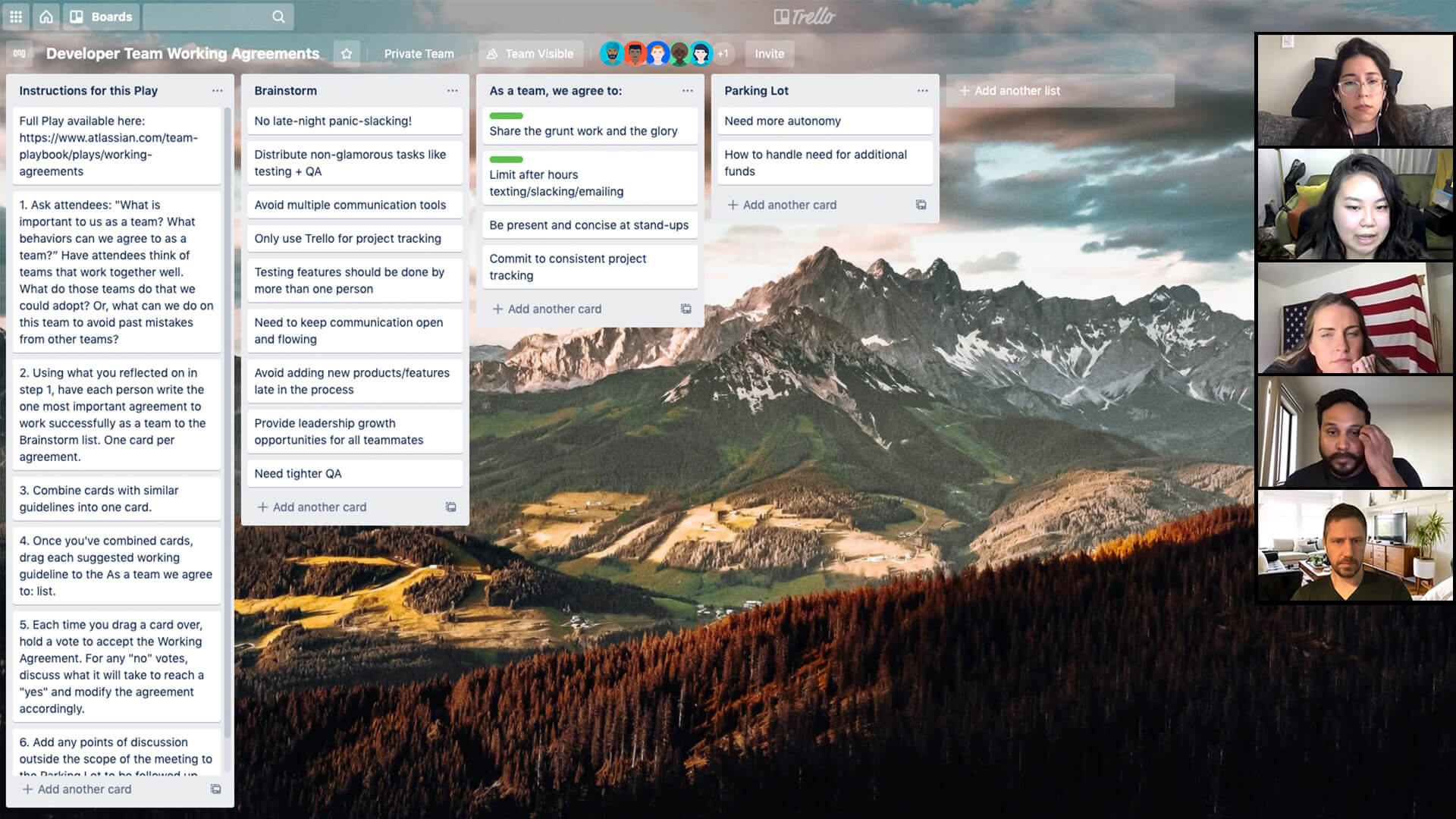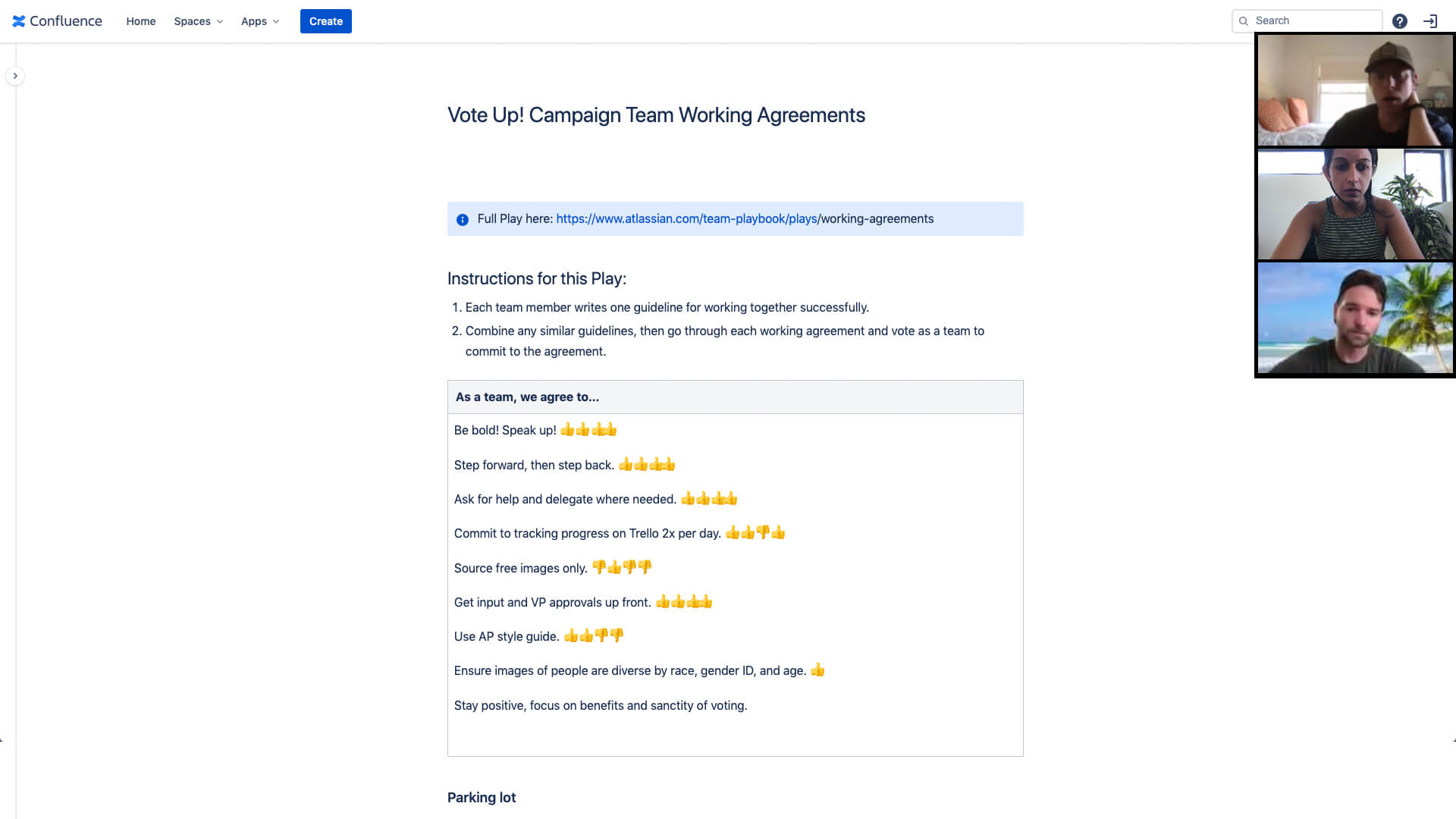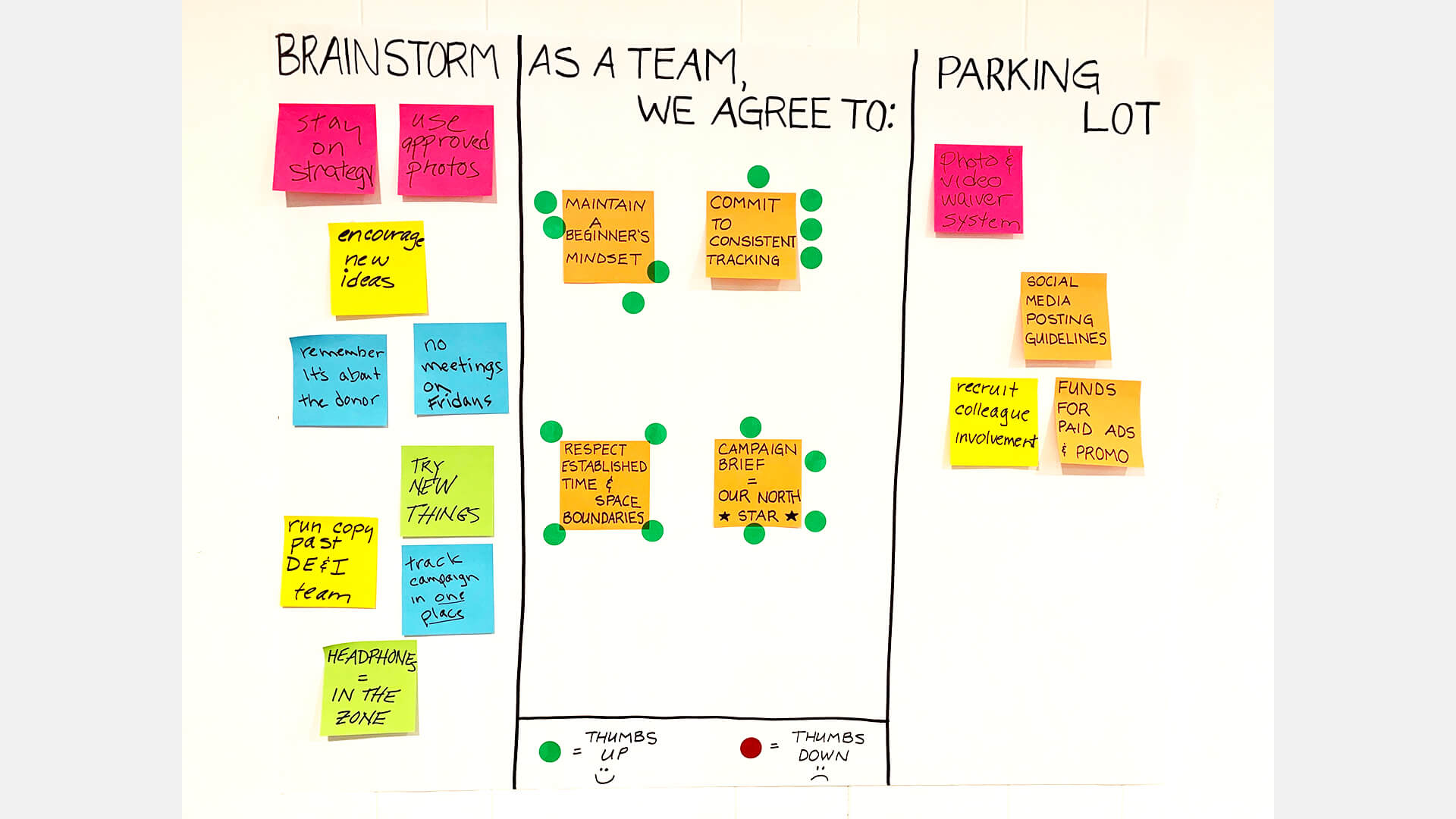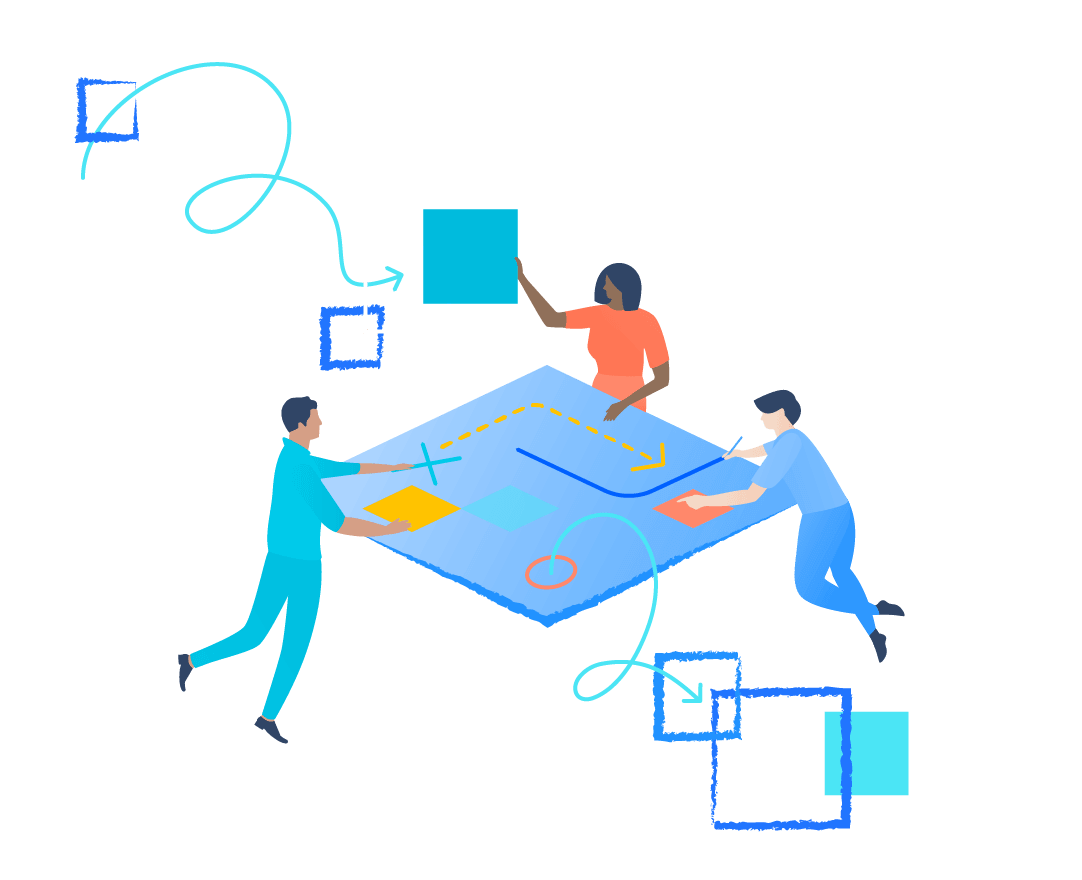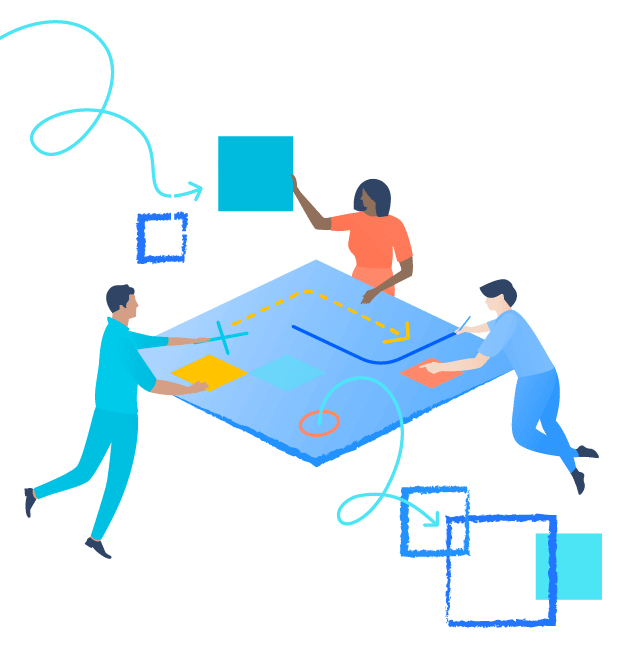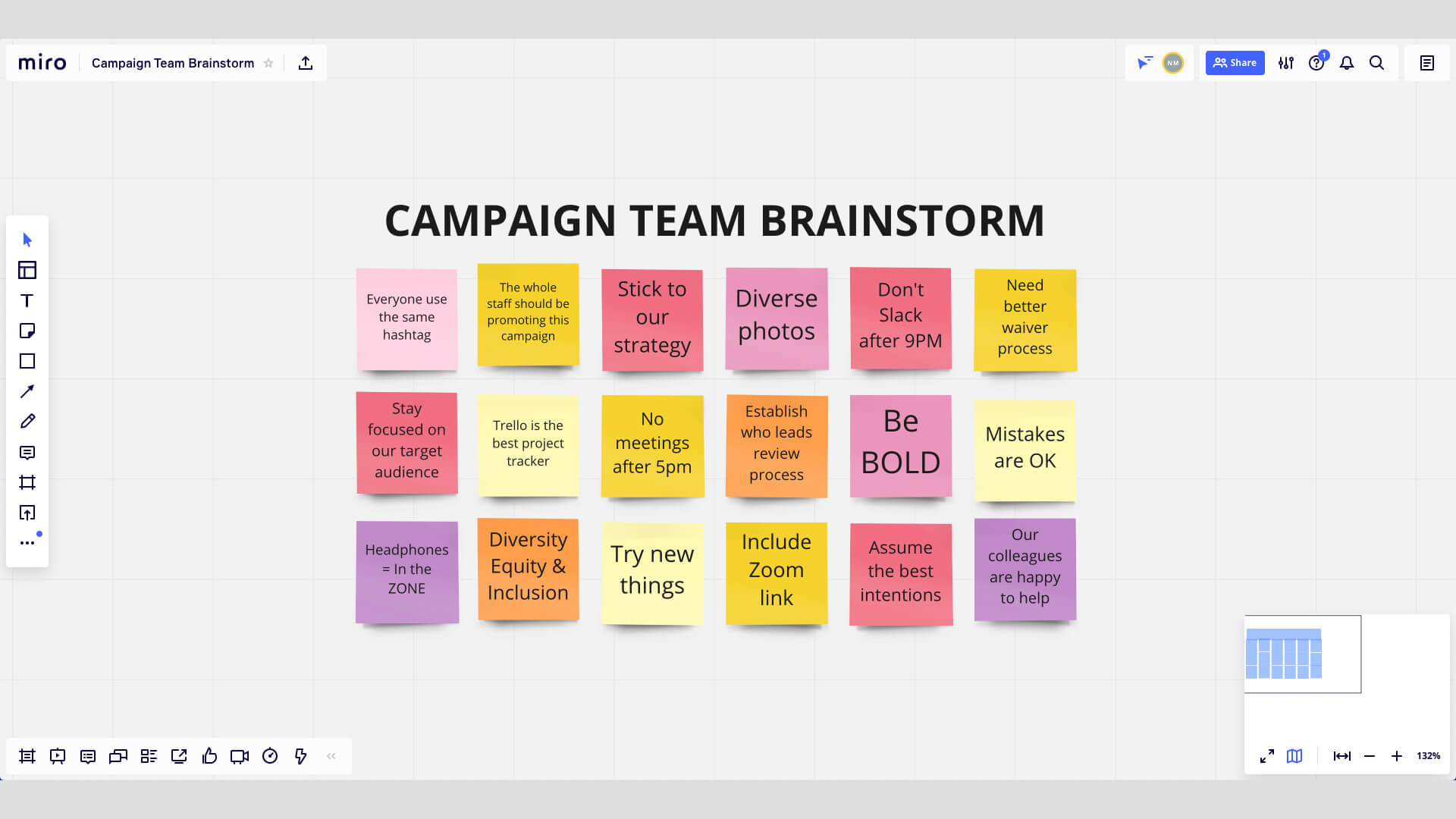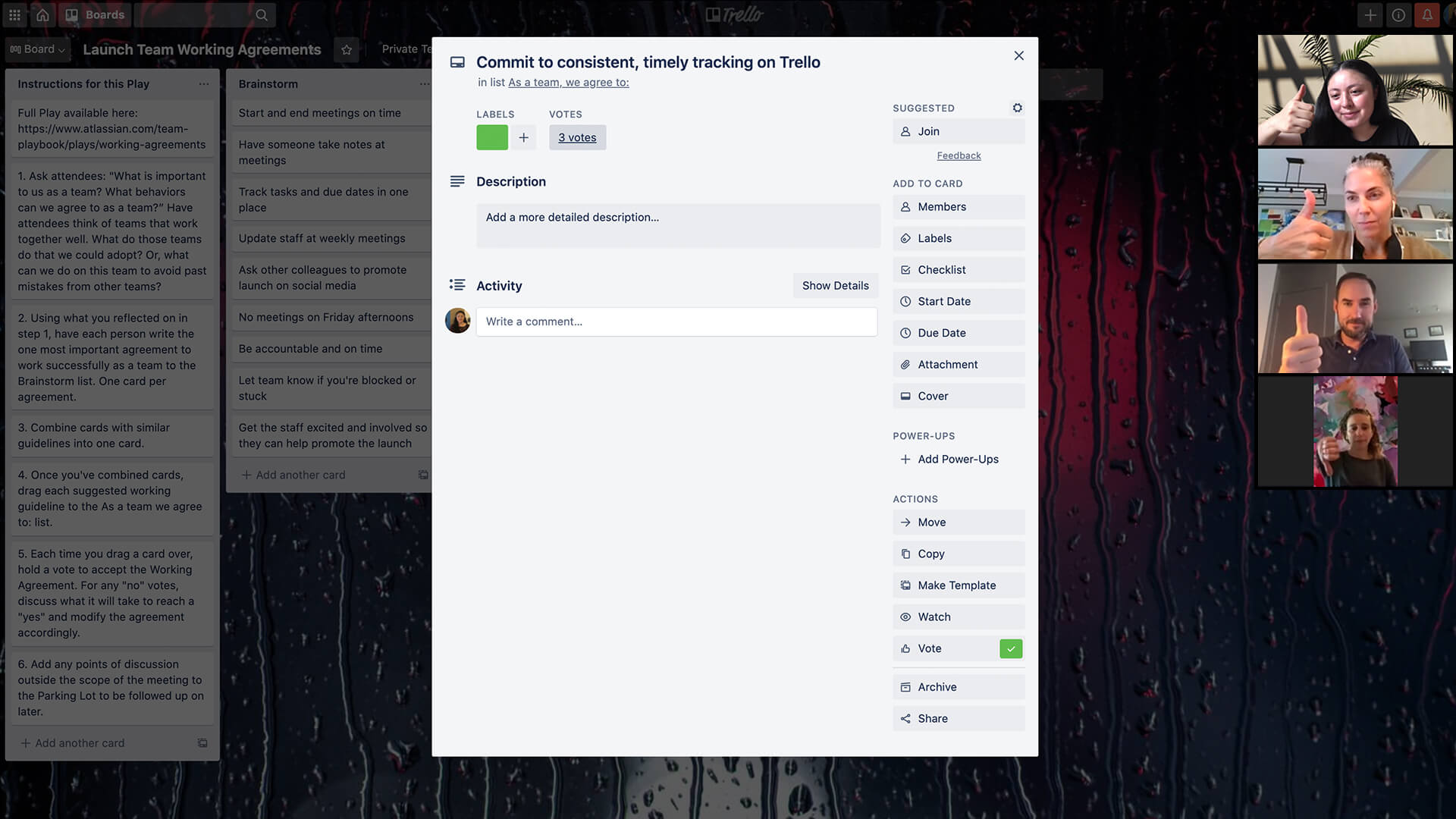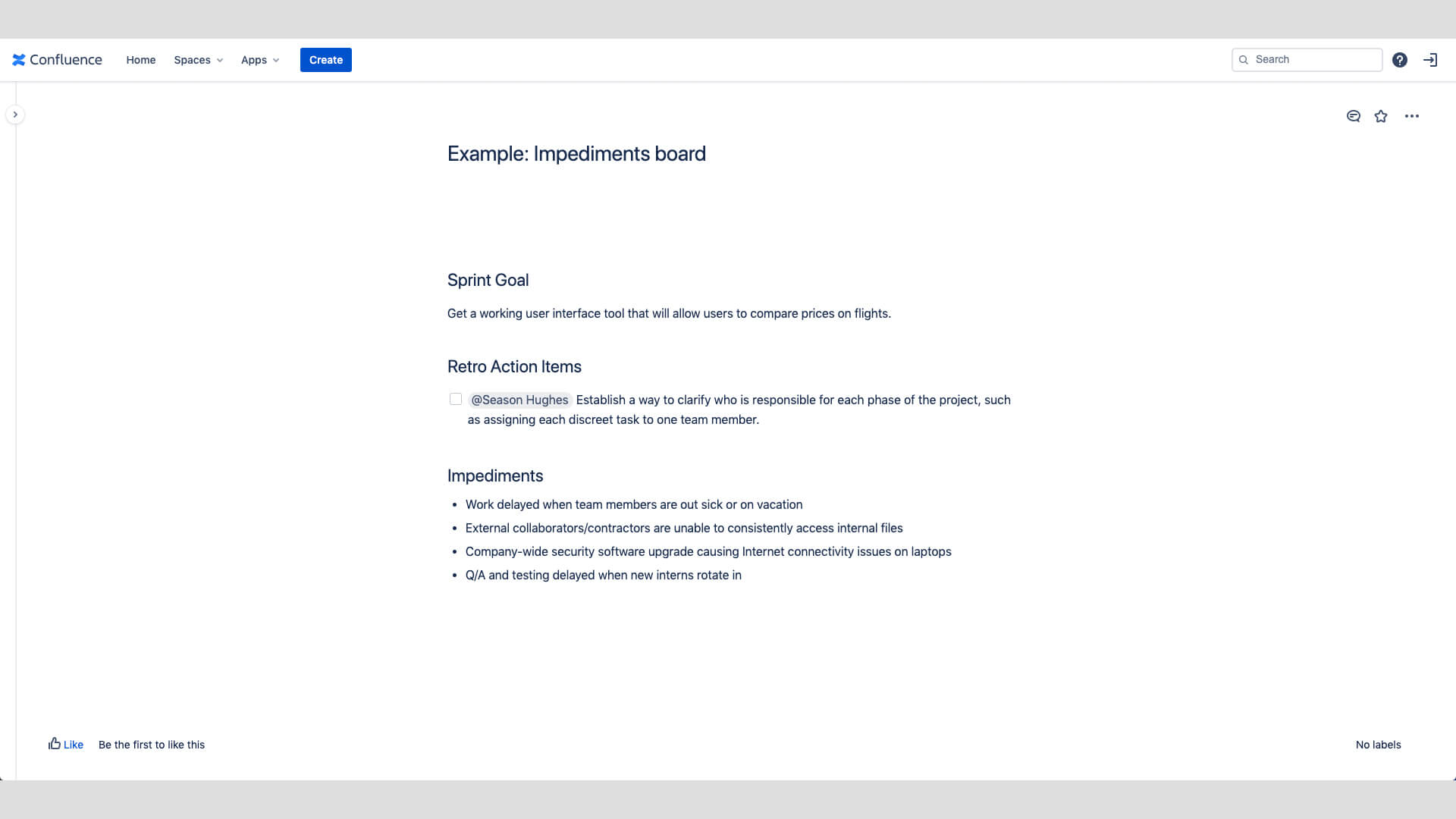Acordos de trabalho em ação
Esses desenvolvedores de software discutem acordos de trabalho no Zoom e usam o Trello para capturar entradas.
Uma equipe de campanha remota elabora ideias e vota nos acordos de trabalho com os quais ela vai se comprometer e captura as informações no Confluence.
Uma equipe de angariação de fundos concluiu a Tática de Acordos de Trabalho.
O que você vai precisar
Remoto
Videoconferência com compartilhamento de tela
Ferramenta de colaboração digital (ver templates)
Presencial
Espaço de reunião
Quadro branco, ou folha grande de papel
Ferramenta de colaboração digital (ver templates)
Marcadores
Notas adesivas
Templates opcionais
Templates da Atlassian
Instruções para executar esta tática
1. Preparação 5 min
Esta é uma tática de três partes. Nas etapas abaixo, vamos analisar os detalhes de cada uma dessas partes. O objetivo é focar em como a equipe vai ter sucesso trabalhando em conjunto, sem passar horas em reuniões!
- Equipe: conclua e faça uma análise assíncrona do pré-trabalho.
- Líder: fique preparado para definir o tom.
- Todos: concorde e se comprometa com os tópicos de discussão em um workshop ao vivo.
Comece criando um documento de colaboração, como quadros do Trello ou páginas do Confluence. Você pode usar os templates vinculados acima para reuniões presenciais ou remotas. Como opção, se você estiver fazendo isso em pessoa, colocar os conceitos em um quadro branco pode aumentar a colaboração. Não se esqueça de documentar as saídas para referência futura.
2. Preparação da equipe 5 min
Envie o template para os membros da equipe antes do workshop ao vivo. Apresente contexto sobre os acordos de trabalho e a importância que eles desempenham no sucesso da equipe. Marque o documento como rascunho ou trabalho em andamento. Envie o pôster da equipe para familiarizar cada membro com o que você está fazendo como grupo e por quê. Não tem uma boa compreensão compartilhada do propósito e dos objetivos da equipe? Comece executando a Tática do pôster da equipe.
Peça aos membros da equipe para que compartilhem o seguinte:
- NOME
- Local de trabalho e fuso horário
- Horas de trabalho e compromissos
- Ambiente de trabalho e preferências
- Como eu gosto de receber feedback
- Contexto sobre mim. Limite isso a um ou dois pontos para este exercício. Para ganhar pontos extras, incentive os membros da equipe a compartilhar o Manual do Usuário para explicar mais sobre como eles trabalham melhor.
DICA: CRIE UM MANUAL DO USUÁRIO
Uma ótima maneira de ajudar novos membros da equipe, contratados, equipes de projeto, partes interessadas e equipes de rede a integrar a equipe logo é concluir um Manual do Usuário que explique como você gosta de trabalhar.
DICA: DISPUTA DE FUSO HORÁRIO
Tem uma equipe distribuída trabalhando em vários fusos horários? Isso pode ajudar a mapear as janelas de colaboração para criar um entendimento compartilhado sobre os horários mais adequados às atividades síncronas
3. Preparação para líderes 10 min
Antes do workshop ao vivo, peça ao líder da equipe para concluir uma primeira tentativa nas duas seções a seguir do template.
Canais de comunicação
Pense em como a equipe vai se comunicar com eficácia. Preencha o canal, o propósito dele, o público e todos os padrões estabelecidos para comunicação nesse espaço. Por exemplo, você pode usar o Confluence para a documentação da fonte oficial de um projeto e o Slack como espaço diário de comunicação da equipe.
Processo de escalonamento
Toda boa equipe sabe que não ter um plano é um plano para falhar. Pense em como você quer que a equipe seja escalonada quando ela não conseguir chegar a um consenso sobre um problema urgente. Preencha quem toma a decisão, como você vai lidar com um escalonamento, qual nível de transparência vai oferecer e como vai informar aos outros sobre a decisão.
Não sabe como lidar com os escalonamentos? Experimente a estrutura de tomada de decisão DACI. Você também pode trabalhar com a equipe para oferecer um caminho de escalonamento limpo que vai descrever as opções de escalonamento e orientar uma melhor tomada de decisão.
4. Prepare o cenário 5 min
Comece a reunião explicando à equipe que, como grupo, vocês estão criando um conjunto de acordos comportamentais para orientar o trabalho em equipe.
Peça à equipe para:
- Manter a mente aberta e curiosa
- Praticar a escuta ativa e incentivar todos a contribuir
- Minimize as distrações e maximize a conexão: desligue os telefones, ative as webcams e ative também a opção “Não perturbe”
- Evitar interromper ou monopolizar a conversa
- Não se esqueça que isso vai ser ajustado no futuro conforme as circunstâncias mudarem
Passe cinco minutos lendo em silêncio com a equipe o rascunho do documento preparado com antecedência. Durante esse período, os membros da equipe podem comentar na página. Comece a fase de discussão pedindo a todos que compartilhem algo que aprenderam sobre outro membro da equipe.
DICA: PESSOAS, NÃO PROCESSOS
Esta tática é sobre trabalhar juntos como pessoas. Se surgirem ideias sobre gerenciamento de trabalho, como documentar processos técnicos ou fluxo de trabalho de gestão de projetos, coloque a equipe de volta no caminho certo e marque um horário para conversar sobre processos específicos de gerenciamento de tarefas para os membros da equipe envolvidos.
5. Estabeleça canais de comunicação 10 min
Reserve dez minutos para discutir a seção Canais de comunicação com a equipe.
Ideias para começar a discussão:
- Alguma adição, remoção ou alteração?
- Quando devemos analisar se isso está funcionando?
- Como queremos que outras equipes, líderes ou partes interessadas se comuniquem com a gente?
DICA: CHEGUE A UM ACORDO, NÃO A UM CONSENSO
Está tendo problemas para chegar a um acordo sobre a melhor maneira de obter resultados como uma equipe? É muito comum que os membros da equipe tenham preferências diferentes; um membro da equipe pode preferir usar o Slack, enquanto outro prefere uma chamada ao vivo pelo Zoom. Utilize a votação para chegar a um acordo confortável para testar em conjunto, com a promessa de que isso não vai ser esquecido! Você vai aprender e melhorar como equipe ao longo do tempo.
6. Estabeleça reuniões 30 min
Preencha a seção de reuniões. Comece com o princípio geral de que o tempo de foco é precioso. Para criar espaço para fazer acontecer (GSD), algumas regras podem ser aplicadas para apoiar isso: ter menos reuniões é melhor e otimiza a comunicação assíncrona em vez da síncrona. Quer saber como você pode fazer a transição da cultura de reuniões da empresa? Comece com o curso sobre Como realizar reuniões eficazes.
Ideias para começar a discussão:
- Quais são os objetivos e resultados desejados?
- Que formato de reunião queremos?
- Quem participa das reuniões? Quais são as funções e equipes dessas pessoas?
- De quais meios e ferramentas precisamos?
- Como vamos aparecer?
- Como gerenciamos o acompanhamento?
- Quando devemos analisar se isso está funcionando?
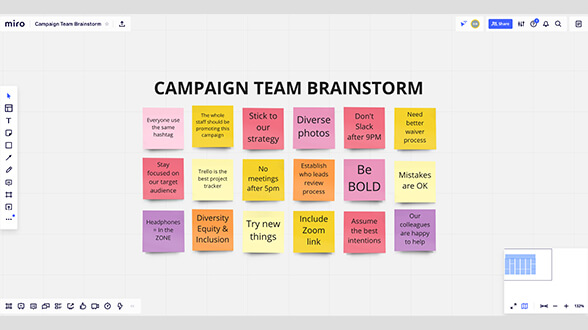
EXEMPLO: IDEIAS
Veja aqui um exemplo do brainstorm de uma equipe em reuniões.
Observe que as ideias variam de produtos a comportamentos e melhorias de processos.
7. Gerenciamento de escalonamento 10 min
Analise a seção do processo de escalonamento em conjunto. Como equipe, discuta quais ações você vai realizar e se comprometa com uma decisão. Garanta que toda a equipe esteja de acordo.
8. Melhoria contínua 10 min
Uma das coisas mais importantes a abordar como equipe é planejar com antecedência para aprender e se adaptar junto. Discuta os rituais e os padrões de comunicação.
Ideias para começar a discussão:
- Compartilhe um comentário
- Lições aprendidas
- Comemore o sucesso
- Marcos pessoais
Acompanhamentos
Revisite com frequência
Analise os contratos de trabalho da equipe com frequência, em especial ao integrar novos membros, durante a reorganização da equipe, quando os cenários de trabalho mudarem ou quando um acordo não puder mais ser mantido. Isso é muito importante se vocês já foram uma equipe presencial que se tornou híbrida ou só remota. Os rituais e acordos vão precisar mudar para acomodar diferentes geografias, fusos horários e tecnologias.
Leia os acordos e faça uma votação para manter ou alterar acordos existentes. Em seguida, faça um brainstorm com os membros da equipe, proponha e vote em eventuais acordos adicionais.
Se um acordo não puder ser cumprido, discuta o que pode estar atrapalhando.
Como qualquer diretriz, os acordos de trabalho são como um músculo que precisa ser flexionado. Reitere os acordos com frequência e fixe o link para a página da equipe no Atlas, incentivando os colegas a consultar esses acordos todo trimestre. Mantenha essa documentação aberta e em destaque durante todos os grandes projetos ou em qualquer momento de conflito.
Variações
Reflexões
Teste o contrato de trabalho com um conjunto de reflexões:
- Pense em equipes que trabalham bem juntas. O que essas equipes fazem que a gente poderia adotar?
- O que a gente pode fazer na equipe para evitar erros passados de outras equipes?
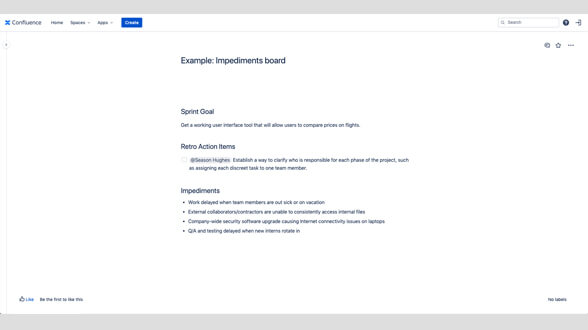
EXEMPLO: QUADRO DE IMPEDIMENTOS
Veja como uma equipe documentou seus desafios em um quadro de impedimentos.
Lidere com desafios
Antes da sessão de Acordos de Trabalho, reúna itens com os quais a equipe está lidando no momento, seja de um quadro de impedimentos (veja o exemplo), uma Retrospectiva, ou apenas desafios conhecidos. Aborde esses temas e faça seu compartilhamento na sessão para comunicar os acordos de trabalho.
Da equipe Atlassian, para você
Fique por dentro nas últimas táticas, dicas e truques com a newsletter mensal.

